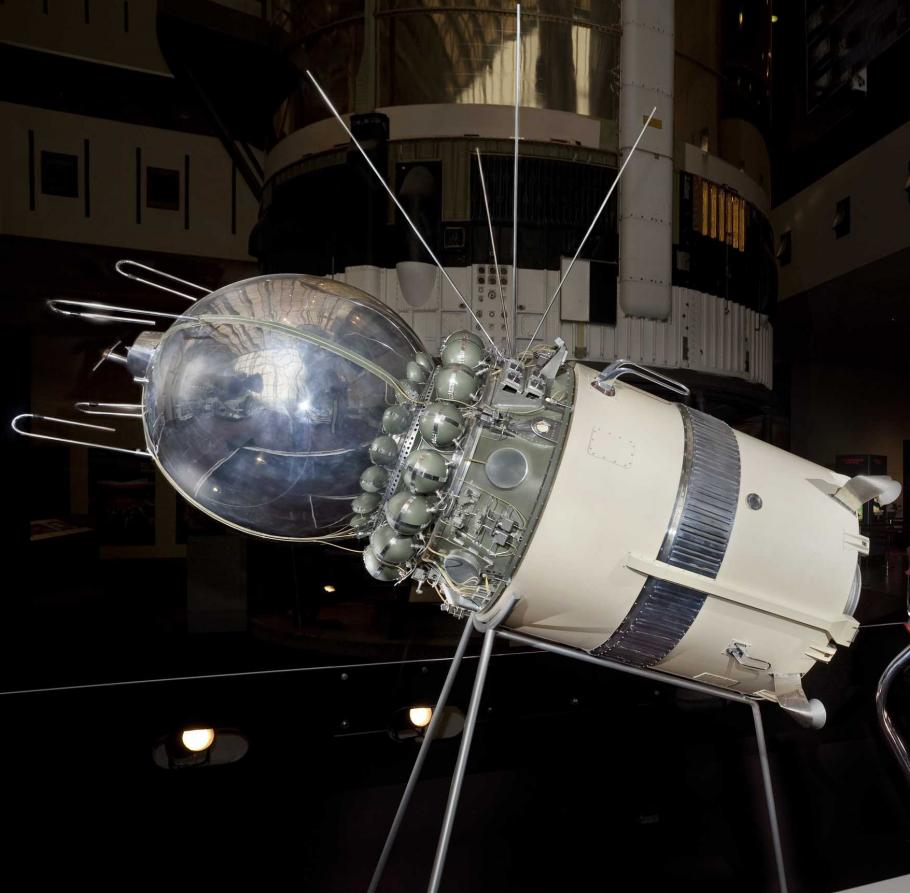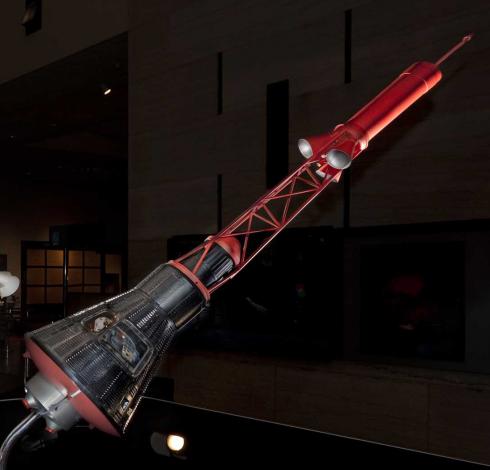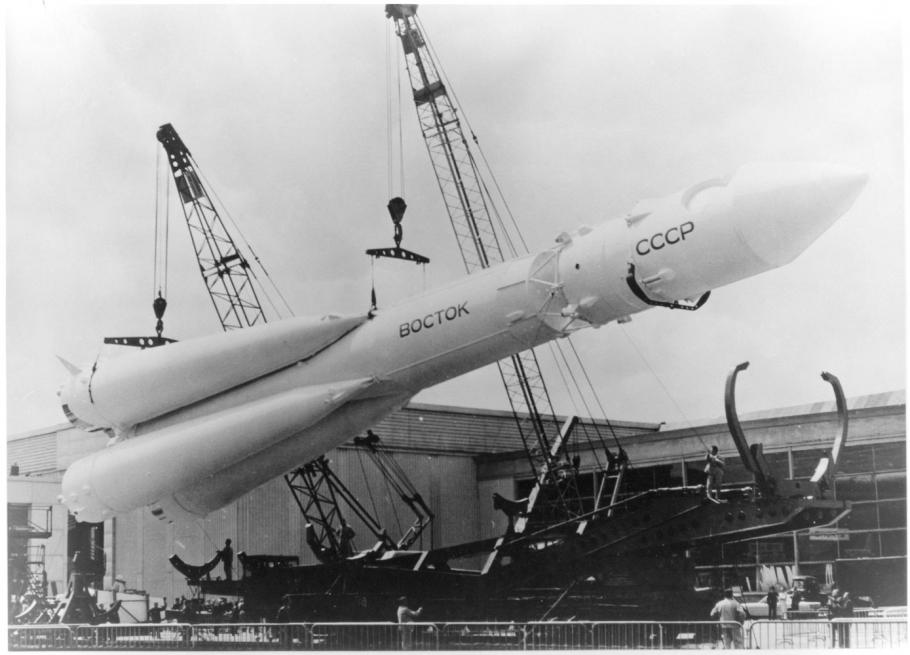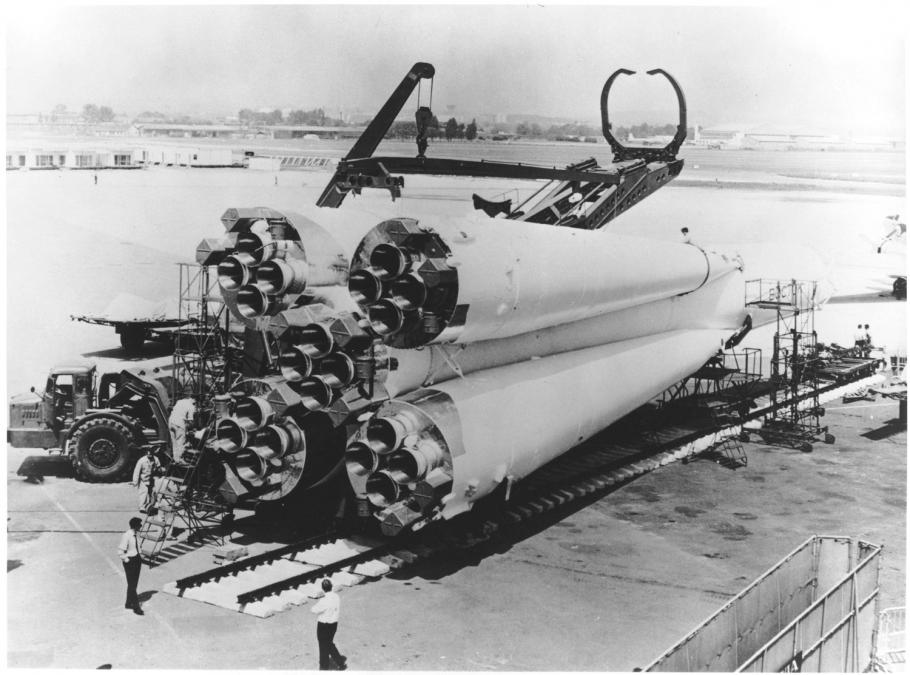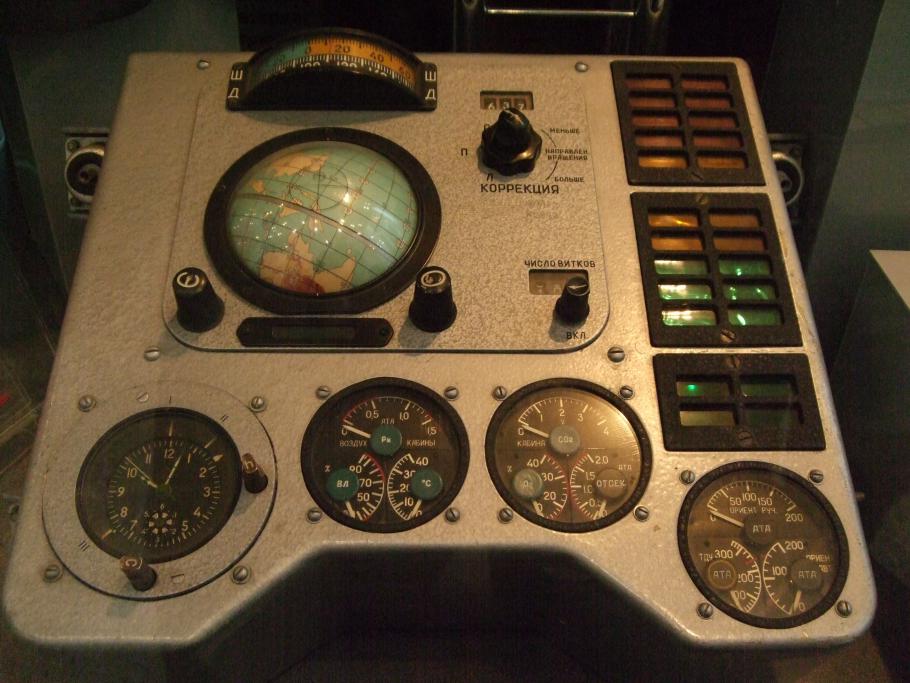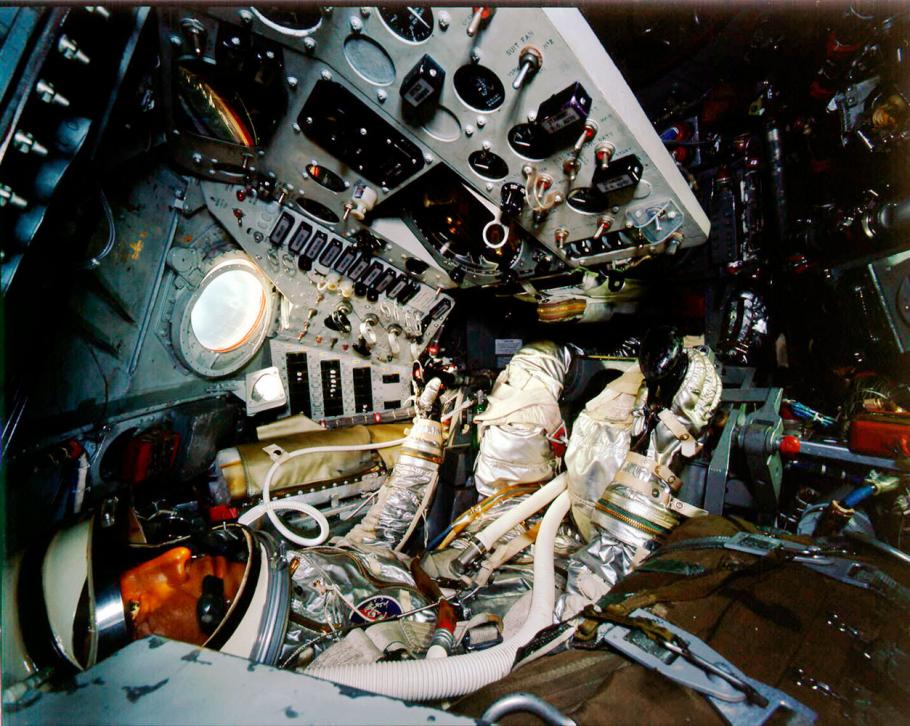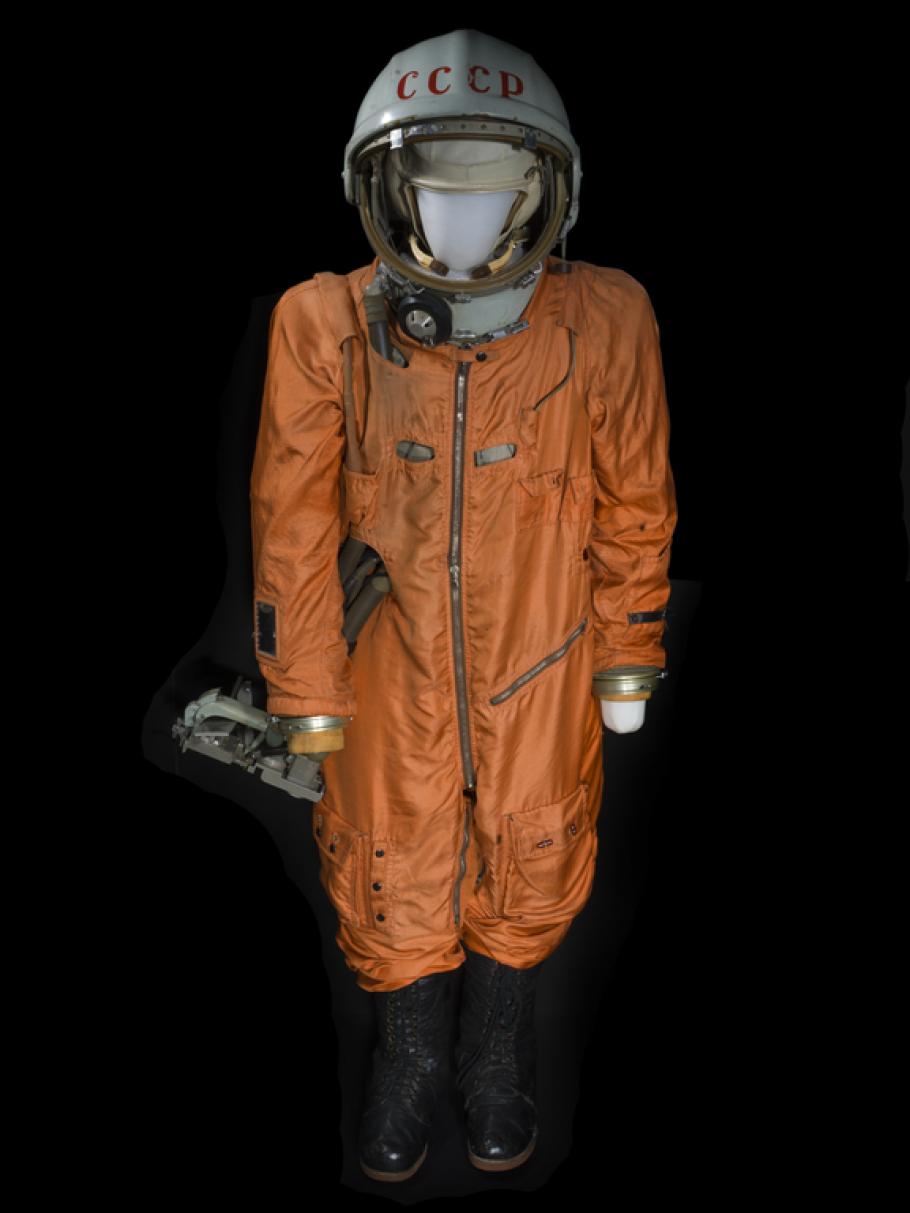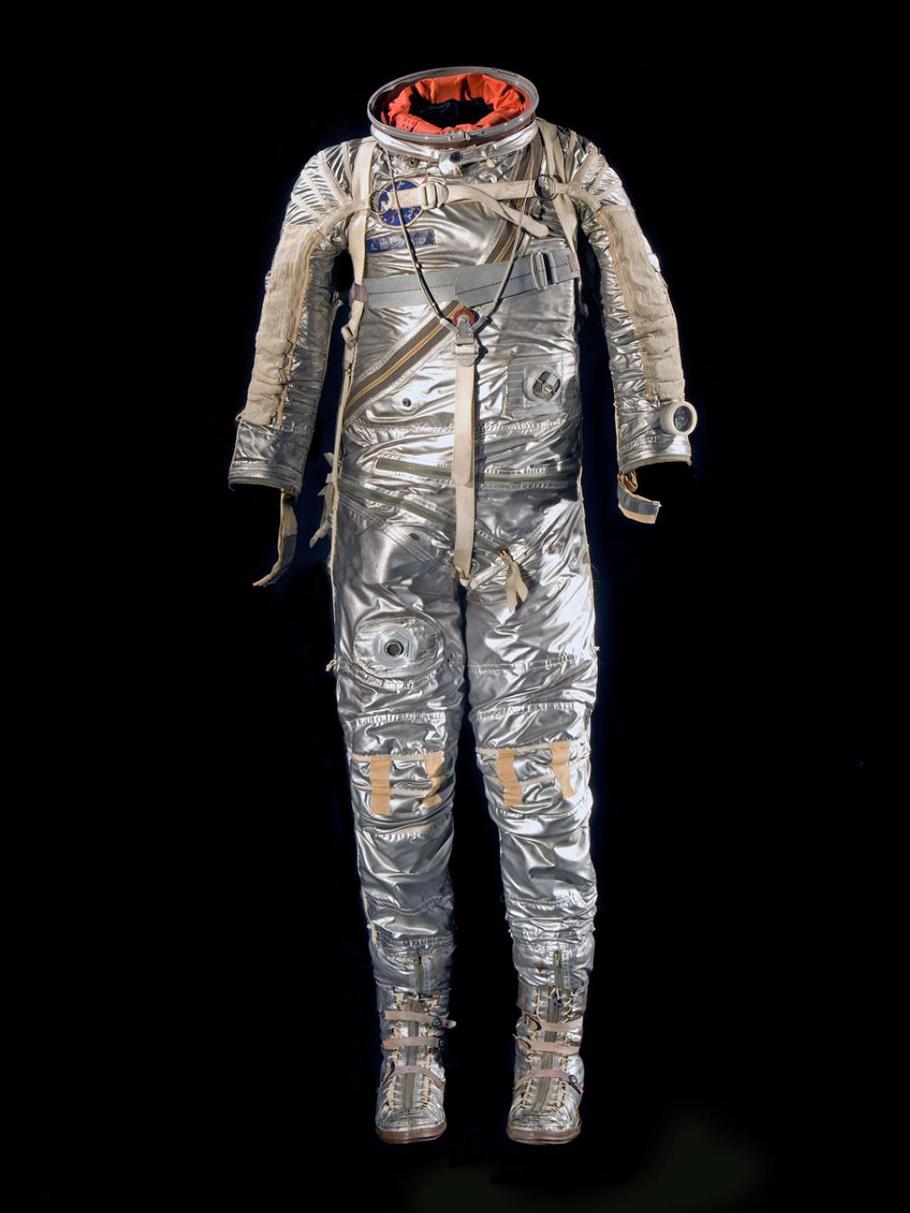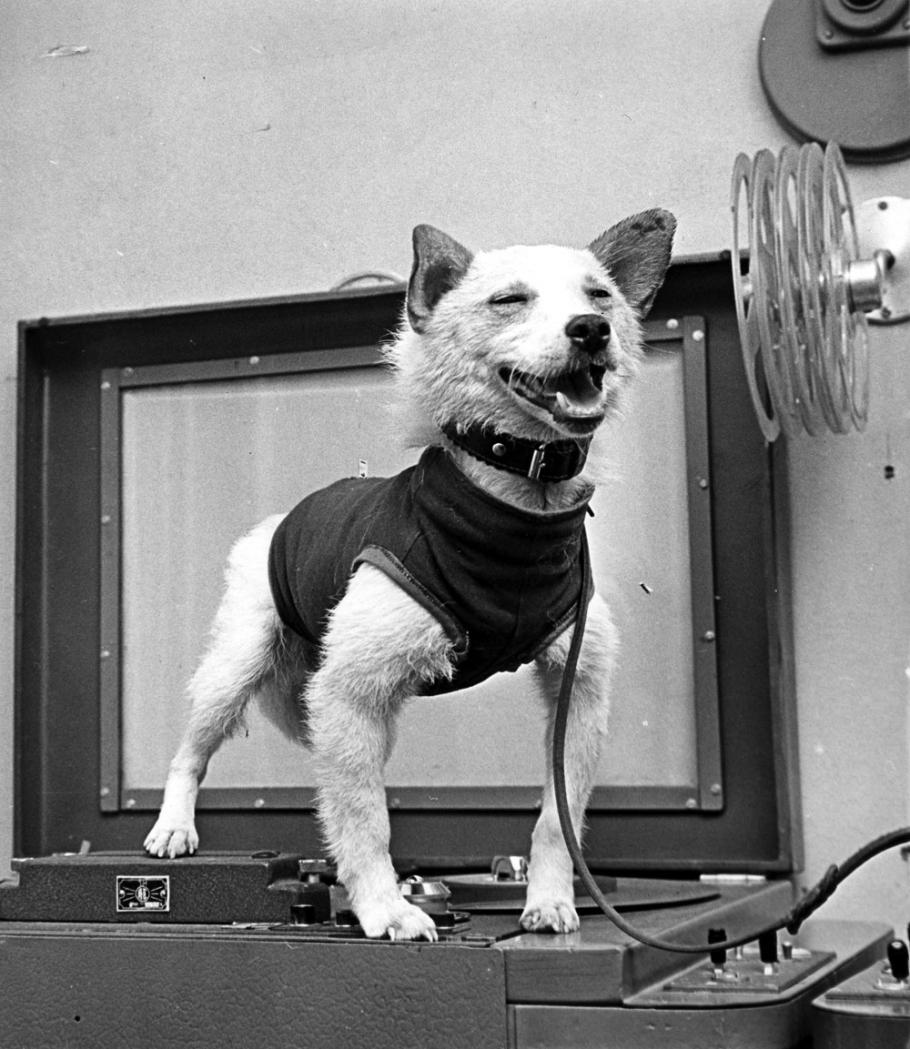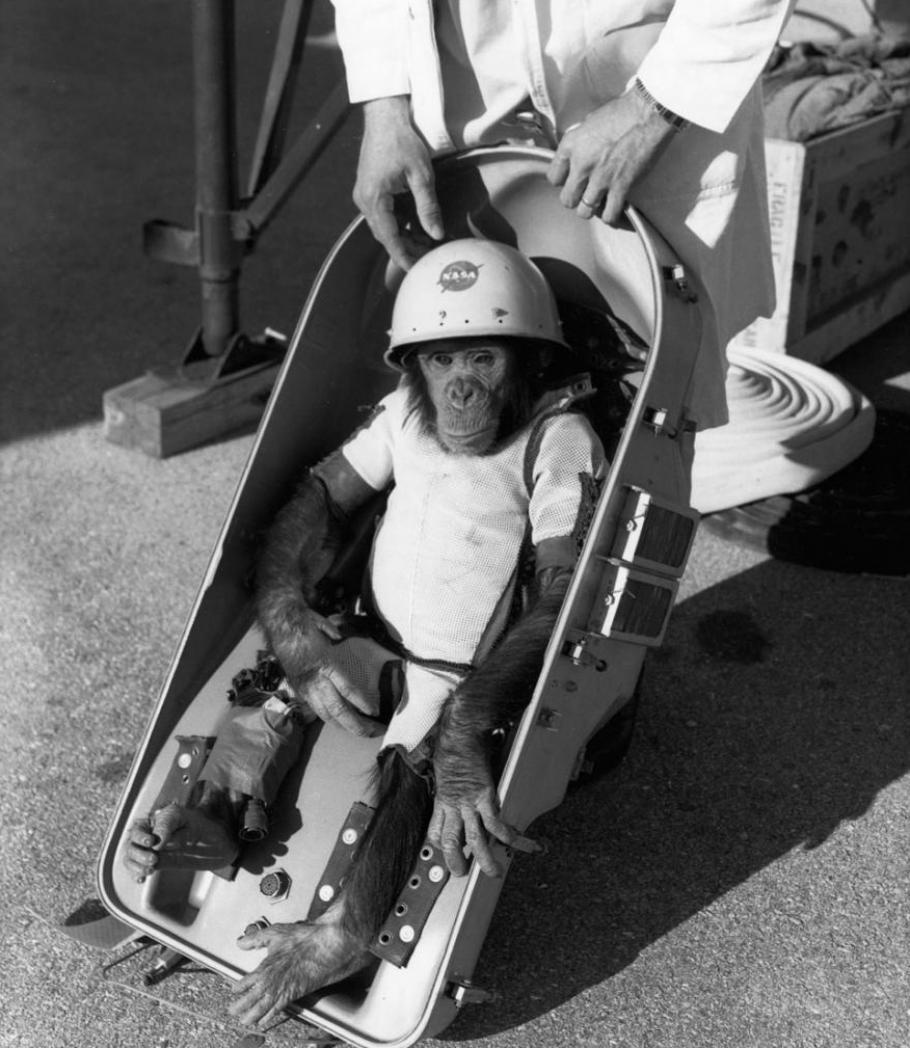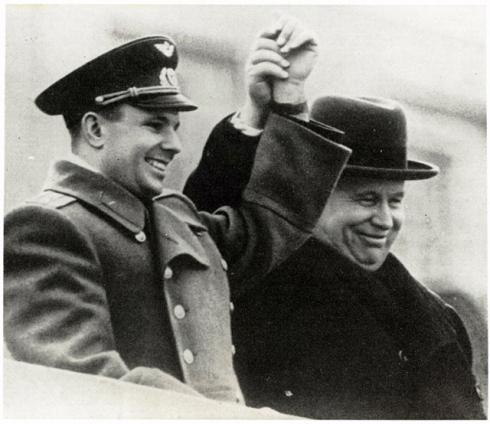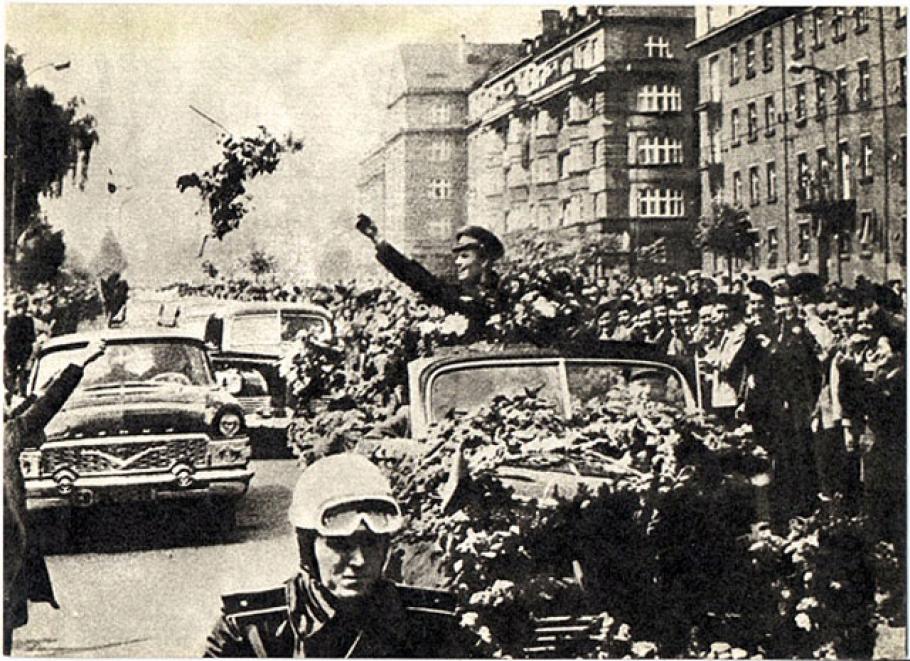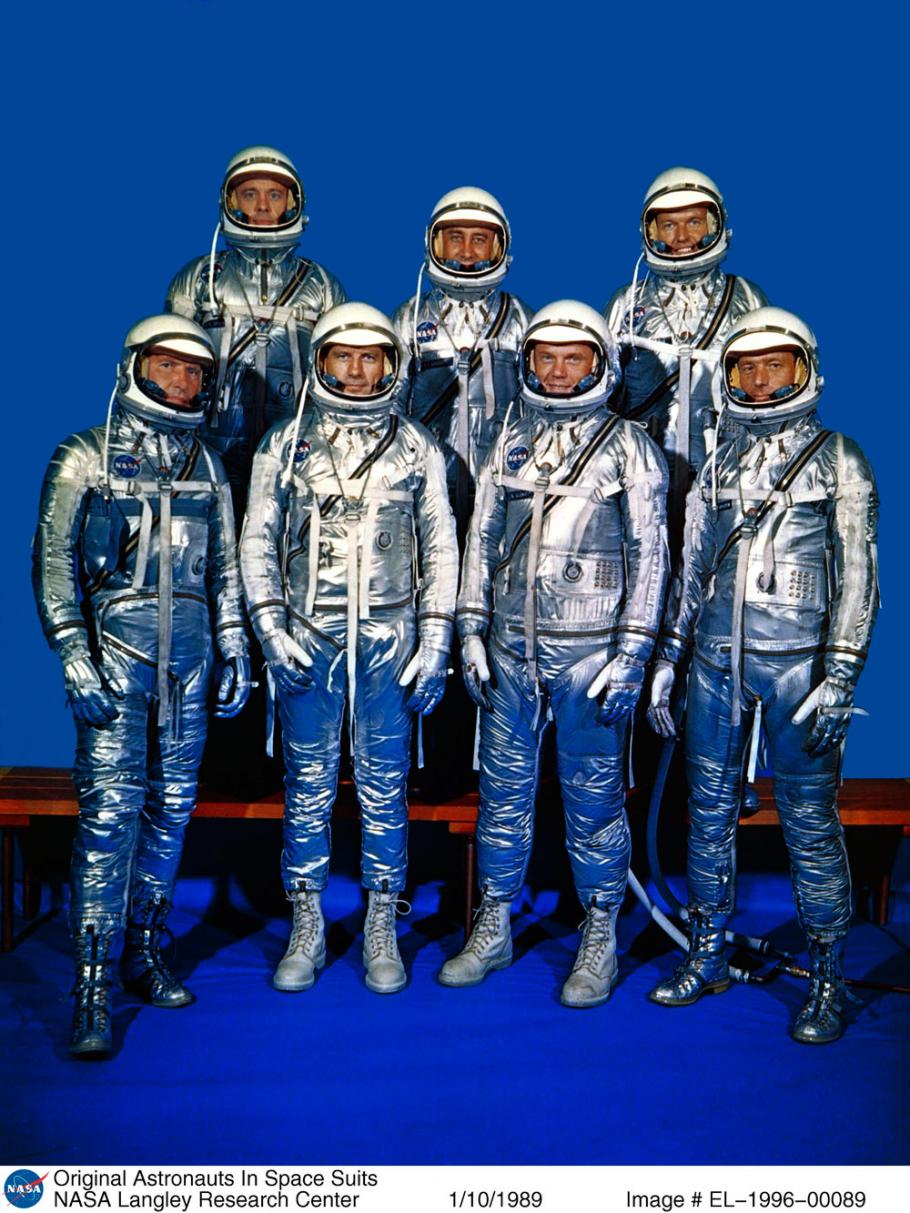In 1961, the first people flew in space: Yuri Gagarin and Alan Shepard. Scroll down to compare their race to space, or click below to jump to a section:
Terminology History Makers Spacecraft Technological Challenges Back on Earth
_
What's in a Name?
Cosmonaut and astronaut are two words that mean the same thing. Both words have the same Greek root, naut, meaning sailor.
Cosmonaut
Cosmo comes from the Greek word for space.
Astronaut
Astro comes from the word for stars.
When the Soviet Union announced Gagarin's flight, they used the word cosmonaut to differentiate him from America's astronauts. Previous generations of Russian space enthusiasts had referred to space travelers as astronauts.
_
Who Were the First Humans in Space?
Yuri Gagarin
Yuri A. Gagarin (1934-1968)
Yuri Gagarin was a young Soviet air force pilot when selected with 20 others for cosmonaut training in 1960. His historic single orbit around Earth on April 12, 1961, took only 108 minutes from ignition to landing. After Gagarin returned and the Soviet press released news of his flight, he became an international hero.
Alan Shepard
U.S. Navy test pilot Alan Shepard joined the astronaut program in 1959.
He became the first American and the second man in space on May 5, 1961, when he piloted the Mercury spacecraft Freedom 7 on a 490-kilometer (300-mile), 15-minute suborbital flight.
_
What Did They Fly?
Vostok 3KA
Vostok 3KA spacecraft carried Yuri Gagarin and other Vostok cosmonauts into space in the early 1960s. This vehicle had a upper stage that lifted the spherical craft above Earth's atmosphere. The spacecraft also had a conical equipment module at its base that carried oxygen and fuel. Engineers coated the spacecraft with a metalicized film to make it highly reflective and visible in the night sky.
By the Numbers
Crew: 1
Length: 5 m (16 ft 5 in)
Diameter: 2.3 m (7 ft 6 in)
Mass: 2,460 kg (5,423 lb)
Manufacturer: OKB-1
Mercury
Astronauts flew two suborbital missions and four orbital missions in Mercury capsules from 1961 through 1963. Titanium was used throughout the capsule because of its light weight and strength. An ablative heat shield on the blunt end, and special shingles on the conical and cylindrical sections, protected against the tremendous heat of reentry. The orange launch escape tower had solid rocket motors to separate the capsule from the launch vehicle in the event of an emergency. If not used, it was jettisoned during the launch.
By the Numbers
Crew: 1
Length: 3.3 m (10 ft 11 in)
Diameter: 1.9 m (6 ft 2 in)
Mass: 1,341 kg (2,956 lb)
Design: NASA Langley Research Center
Manufacturer: McDonnell Aircraft
Shepard named the Mercury capsule he flew in "Freedom 7," the number signifying the seven Mercury astronauts; NASA called the mission Mercury-Redstone 3 (MR-3).
NASA gave "Freedom 7" to the Smithsonian in October 1961, the first manned spacecraft accessioned into the National Collection.
_
Technological Challenges
To launch humans into space, both the United States and the Soviet Union independently perfected six systems: launch vehicle, spacecraft, life support, pilot training, command and control, and recovery.
Launch Vehicle
Both the Soviet Union and the United States adapted existing military ballistic missiles to launch the first humans into space.
The Soviets used a modified R-7 intercontinental ballistic missile (ICBM) to launch Yuri Gagarin into space from Baikonur in the Kazakh Republic in 1961.
The Vostok launch vehicle at the 1967 Paris Air Show, viewed from the front.
The Vostok launch vehicle at the 1967 Paris Air Show, viewed from behind.
The R-7, the world's first ICBM, had launched Sputnik, the first satellite, in 1957. An extra rocket stage was added atop the missile to convert it to a Vostok.
A modified U.S. Army Redstone launched Alan Shepard into space from Cape Canaveral in 1961.
NASA also used a Redstone for Virgil Grissom's suborbital Mercury flight. A modified U.S. Air Force Atlas ICBM launched John Glenn from Cape Canaveral on the first American orbital mission on February 20, 1962. NASA used Atlas rockets for the next three Mercury orbital flights.
Spacecraft
The first spacecraft had to be light enough to carry the passenger into space and yet rugged enough to withstand the stresses and heating of launch and reentry.
Soviet designers based their design for a recoverable, human-carrying spacecraft on their experience with sending dogs into space. The spherical return capsule used parachutes to slow its descent, but the cosmonaut had to eject from the capsule at an altitude of 7,000 meters (23,000 feet) to survive the landing. Early Soviet reports of Gagarin's flight omitted this detail.
An instrument panel in the vehicle.
NASA designed the Mercury capsule for a water landing. A parachute deployed at 7,500 meters (24,500 feet) to slow the spacecraft. Unlike a Vostok cosmonaut, the astronaut stayed inside during the entire descent. During launch, an escape rocket on top could pull the capsule away in an emergency.
The interior of Shepard's Freedom 7 capsule.
Life Support
Both nations had experience in high-altitude flying. U.S. and Soviet engineers adapted high-altitude flight suits to their spacecraft life support systems to ensure survival in the event of an emergency.
Gagarin had a pressure layer that formed a sealed environment and allowed him to breath. Beneath that layer he wore thermal clothes. Gagarin needed this suit to survive the high-altitude parachute drop that concluded his flight.
Alan Shepard wore a modified version of a U.S. Navy Mark IV flight suit for his Freedom 7 mission.
The silver-colored coating was meant to increase his visibility if an emergency rescue was needed.
The suit was snug-fitting and would pressurize the lower body to avoid blood pooling in the pilot’s legs. The suit was adapted from its original cockpit design to one that would integrate into a spacecraft, the Mercury capsule. Engineers added additional buckles and pulleys to keep the suit in place for that one minute of microgravity that Shepard would experience during his flight. They added restraints to the shoulders so that the astronaut’s arms would not float uncontrolled while weightless. The gloves of the suit also feature fingertip flashlights so that the astronaut could focus a beam of light on any given point in the cockpit.
Take a closer look at Yuri Gagarin's training suit. Notable features include a visored helmet that is not detachable from the suit, the inflatable rubber collar for use in the event of water landing, and the bright orange nylon oversuit, which has a mirror sewn into the sleeve to help the cosmonaut locate hard-to-see switches and gauges.
A Cosmonaut's Best Friend is His Dog
The Soviet Union launched the dog Laika into space in November 1957 and proved it was possible to maintain life in space for at least a limited amount of time. Further Soviet and U.S. flights with animals confirmed this.
The U.S.S.R. launched two dogs, Belka and Strelka, into orbit in August 1960. This day-long mission was one of several test orbits of the Vostok hardware. The dogs survived and lived to produce litters of puppies.
NASA launched the chimpanzee Ham on a suborbital flight in January 1961. Ham survived the flight in good shape and lived until 1983.
Ham, shown here in his couch after ocean recovery.
Pilot Training
In addition to advanced flight training and teaching their pilots to withstand high gravitational forces, the Soviets emphasized fitness training for their cosmonaut candidates.
NASA used the U.S. Navy's centrifuge at Johnsville, Pennsylvania, to test astronauts' ability to withstand severe acceleration and deceleration forces.
Command and Control
To assure a safe flight, each country had to establish a network to track its spacecraft and communicate with them.
During the first four years of Soviet human spaceflight, the U.S.S.R. relied only on ground stations within the country to track space flights. As a result, the cosmonauts were out of touch with ground control for about half of each orbit.
The United States developed a worldwide network of ground stations, ships, and aircraft. It provided nearly continuous contact between the astronaut and ground control during the early suborbital and orbital missions.
Recovery
Once the capsule touched down, crews had to arrive quickly to safely recover it and the occupant.
The Vostok and Gagarin landed on the ground inside the U.S.S.R. The Soviet government could therefore use its existing search and rescue forces and avoid revealing any failures, mishaps, or details about its space flight technology.
After landing in the ocean, Mercury astronauts usually left their capsules. U.S. military ships and aircraft in the landing zone recovered the capsules and astronauts.
U.S. officials needed timely and accurate information on the Soviet space program, but it was difficult to obtain because of the secrecy surrounding it. Only the U.S. intelligence agencies could provide the information needed. Their worldwide network of ground stations, ships, and aircraft tracked Soviet rockets and spacecraft and intercepted signals sent between them and ground controllers. Analysts evaluated the data to assess the current and future Soviet space program.
_
What Comes Next?
After they landed, the cosmonauts and astronauts immediately became national heroes, and their work continued as exemplars of their national ideals.
In the American tradition of returning heroes, Alan Shepard received an award from President Kennedy at the White House and a parade down Pennsylvania Avenue.
The U.S.S.R. and United States focused much of their space race public diplomacy on convincing other countries of their best intentions and showcasing their capabilities in space. This required goodwill tours of cosmonauts, astronauts, and space hardware.
The first human flights in space left indelible marks on both countries’ popular culture. Arts, literature, toys, and collectables gave tribute to these space pioneers. From the moment the Soviet news agency announced his flight, Yuri Gagarin’s face became famous throughout the world.
Next in Space
Gagarin and Shepard's missions were the first of their kind, but by no means the last. Discover what came next for space programs in the USSR and US.
The first six cosmonauts, left to right:
Pavel Popovich, Yuri Gagarin, Valentina Tereshkova, Adrian Nikolaev, Valery Bykovsky, German Titov
Vostok 2
- Date: August 6-7, 1961
- Pilot: German Titov
- Flight Time: 1 day, 1:18
- Orbits: 17
Vostok 3
- Date: August 11-15, 1962
- Pilot: Adrian Nikolaev
- Flight Time: 3 days, 22:22
- Orbits: 64
Vostok 4
- Date: August 12-15, 1962
- Pilot: Pavel Popovich
- Flight Time: 2 days, 22:52
- Orbits: 48
Vostok 5
- Date: June 14-19, 1963
- Pilot: Valery Bykoysky
- Flight Time: 4 days, 23;07
- Orbits: 81
Vostok 6
- Date: June 16-19, 1963
- Pilot: Valentina Tereshkova
- Flight Time: 2 days, 22:50
- Orbits: 48
Top row, left to right: Alan Shepard, Gus Grissom, Gordon Cooper. Front row, left to right: Walter Schirra, Deke Slayton, John Glenn, Scott Carpenter.
Mercury Liberty Bell 7
- Date: July 21, 1961
- Pilot: Virgil "Gus" Grissom
- Flight Time: 0:15
- Orbits: Suborbital
Mercury Friendship 7
- Date: February 20, 1962
- Pilot: John Glenn
- Flight Time: 4:55
- Orbits: 3
Mercury Aurora 7
- Date: May 24, 1962
- Pilot: Scott Carpenter
- Flight Time: 4:55
- Orbits: 3
Mercury Sigma 7
- Date: October 3, 1962
- Pilot: Walter Schirra
- Flight Time: 9:13
- Orbits: 6
Mercury Faith 7
- Date: May 15, 1963
- Pilot: Gordon Cooper
- Flight Time: 1 day, 10:20
- Orbits: 22



